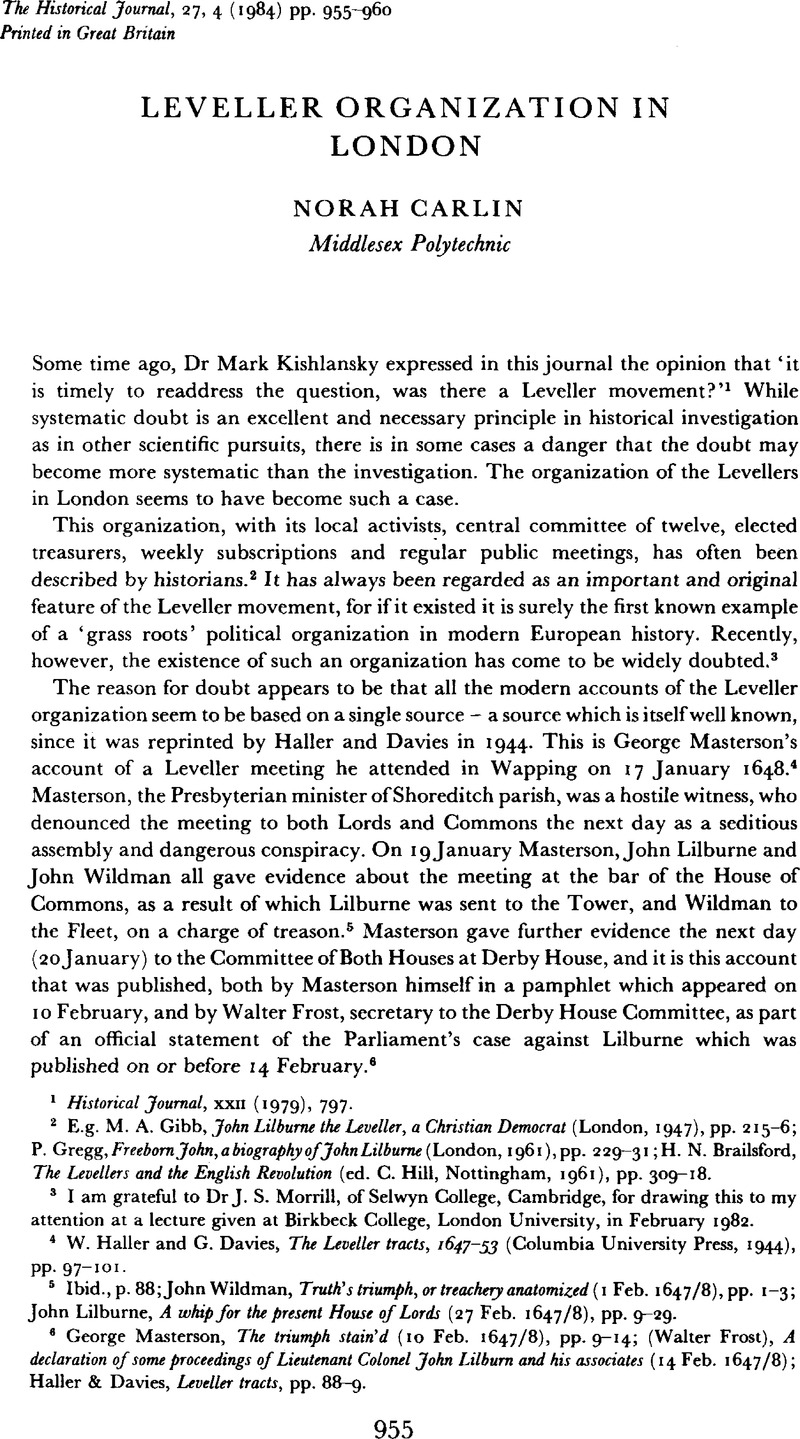Article contents
Leveller Organization in London
Published online by Cambridge University Press: 11 February 2009
Abstract

- Type
- Communications
- Information
- Copyright
- Copyright © Cambridge University Press 1984
References
1 Historical Journal, XXII (1979), 797Google Scholar.
2 E.g. Gibb, M. A., John Lilburne the Leveller, a Christian Democrat (London, 1947), pp. 215–6Google Scholar; Gregg, P., Freeborn John, a biography of John Lilburne (London, 1961), pp. 229–31Google Scholar; Brailsford, H. N., The Levellers and the English Revolution (ed. Hill, C., Nottingham, 1961), pp. 309–18Google Scholar.
3 I am grateful to Dr J. S. Morrill, of Selwyn College, Cambridge, for drawing this to my attention at a lecture given at Birkbeck College, London University, in February 1982.
4 Haller, W. and Davies, G., The Leveller tracts, 1647–53 (Columbia University Press, 1944), pp. 97–101Google Scholar.
5 Ibid., p. 88; Wildman, John, Truth's triumph, or treachery anatomized (1 02 1647/1648), pp. 1–3Google Scholar; Lilburne, John, A whip for the present House of Lords (27 02 1647/1648), pp. 9–29Google Scholar.
6 Masterson, George, The triumph stain'd (10 02 1647/1648), pp. 9–14Google Scholar; (Walter Frost), A declaration of some proceedings of Lieutenant Colonel John Lilbum and his associates (14 Feb. 1647/8); Haller, & Davies, , Leveller tracts, pp. 88–9Google Scholar.
7 Wildman, Truth's triumph, title-page.
8 Jab., Norris, A lash for a lyar, or the stayner stayned (22 02 1647/1648), title-pageGoogle Scholar.
9 Lilburne, A whip, p. 9.
10 Ibid. pp. 10–11.
11 Ibid. pp. 9–11; Wildman, , Truth's triumph. pp. 22–3Google Scholar.
12 Haller, and Davies, , Leveller tracts, p. 98Google Scholar.
13 Wildman, , Truth's triumph, p. 9Google Scholar.
14 Lilburne, , A whip, p. 11Google Scholar. Lilburne later explained the reference to blue ribbons (which Masterson seems to have had difficulty in remembering precisely): ‘I was of opinion, and still am, that publick knowledge of a vigorous and strong acting in so transcendent, gallant and just a Petition as this is, in the day of a feared universal storm in England, will be of greater security and protection, then to be one of Sir Thomas Fairfax his Army, and to wear his colours of blue Ribbons in his hat.’ An impeachment of high treason against Oliver Cromwell and his son in law Henry Ireton esquires (10 Aug. 1649), p. 41.
15 Wildman, , Truth's triumph, p. 7Google Scholar; Lilburne, , An impeachment of high treason, pp. 32–4Google Scholar.
16 Brailsford, , The Levellers, p. 326Google Scholar.
17 Haller, and Davies, , Leveller tracts, p. 101Google Scholar.
18 Wildman, , Truth's triumph, p. 9Google Scholar.
19 Norris, , A lash for a lyar, pp. 5, 6–14Google Scholar.
20 Haller, and Davies, , Leveller tracts, p. 93Google Scholar.
21 Lilburne, , A whip, p. 4Google Scholar.
22 This work is given as a reference for the 17 January 1648 meeting by Gibb, Gregg and Haller and Davies in the places cited above. While Gibb also refers to the pamphlet as ‘refuting Masterson's charges’ (Lilburne, p. 273), it should be understood that, as in A whip for the present House of Lords, it is the charge of conspiracy, and not the organizational details, which Lilburne refutes.
23 See Brailsford, , The Levellers, pp. 561–3Google Scholar.
24 Lilburne, , A whip, p. 17Google Scholar.
25 A Perfect Diurnall, 17–24 January 1647/8.
26 The pagination of this pamphlet is erratic. The passage reproduced here occurs on pages 27–29; though they are numbered 21–23, they are not the first to be so numbered. The passage takes the form of a quotation from Lilburne's speech at the bar of the House of Commons on 19 January 1648, and is addressed to the Speaker.
- 10
- Cited by




